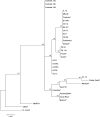Phylogeography of Rickettsia rickettsii genotypes associated with fatal Rocky Mountain spotted fever
- PMID: 24957541
- PMCID: PMC4155566
- DOI: 10.4269/ajtmh.14-0146
Phylogeography of Rickettsia rickettsii genotypes associated with fatal Rocky Mountain spotted fever
Abstract
Rocky Mountain spotted fever (RMSF), a tick-borne zoonosis caused by Rickettsia rickettsii, is among the deadliest of all infectious diseases. To identify the distribution of various genotypes of R. rickettsii associated with fatal RMSF, we applied molecular typing methods to samples of DNA extracted from formalin-fixed, paraffin-embedded tissue specimens obtained at autopsy from 103 case-patients from seven countries who died of RMSF. Complete sequences of one or more intergenic regions were amplified from tissues of 30 (29%) case-patients and revealed a distribution of genotypes consisting of four distinct clades, including the Hlp clade, regarded previously as a non-pathogenic strain of R. rickettsii. Distinct phylogeographic patterns were identified when composite case-patient and reference strain data were mapped to the state and country of origin. The phylogeography of R. rickettsii is likely determined by ecological and environmental factors that exist independently of the distribution of a particular tick vector.
© The American Society of Tropical Medicine and Hygiene.
Figures





References
-
- Wilson LB, Chowning WM. Studies in Piroplasma hominis. (Spotted fever or “tick fever” of the Rocky Mountains) J Infect Dis. 1904;1:31–57. - PubMed
-
- Philip RN. Rocky Mountain Spotted Fever in Western Montana: Anatomy of a Pestilence. Hamilton, MT: Bitter Root Valley Historical Society; 2000. pp. 55–69.
-
- Maxey EE. Some observations on the so-called spotted fever of Idaho. Med Sentinel. 1899;7:432–438.
-
- Spencer WO. Mountain or spotted fever, as seen in Idaho and eastern Oregon. Med Sentinel. 1907;15:532–537.
-
- Ricketts HT. Some aspects of Rocky Mountain spotted fever as shown by recent investigations. Med Record. 1909;76:843–855. - PubMed
Publication types
MeSH terms
Substances
LinkOut - more resources
Full Text Sources
Other Literature Sources
Miscellaneous

